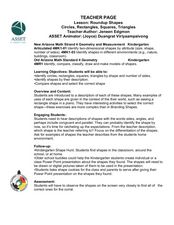Curated OER
Keeping Our Surroundings Clean
Students define the word environment. In this environmental awareness lesson students, orally make a list of at least 6 ways to keep our environment clean. Students individually create posters that show how to keep the environment clean.
Curated OER
Classification
Fifth graders analyze the necessity of classification. They distinguish between living and nonliving things in our world and recognize the six life functions of living things by identifying 15 classroom objects.
Curated OER
Caring for the Land
Students study soil management and issues relating to agriculture and the environment. In this agriculture and environment lesson plan, students define the terms farmer, environmentalist, and activist. Students use a Venn diagram to...
Curated OER
Circles, Rectangles, Squares, Triangles
Students identify, compare and classify the various shapes. For this shapes lesson, students listen to descriptions of shapes with words such as sides, angles, congruent, and parallel. Students then give the teacher examples of shapes...
Curated OER
Pond Water
Students explore a creek environment. They make observations, identify the living and nonliving factors in the environment and collect a plankton sample to take back to the classroom. In addition, they look at plankton under a microscope.
Curated OER
Cathlapolte.... Catching Time's Secrets
Third graders investigate nature by studying a Chinook village from the past. In this sustainable living lesson, 3rd graders examine the architecture, environment and activities of the Chinook people. Students create a "needs" list of...
Curated OER
RIGHT TO EQUAL OPPORTUNITY
Students learn the importance of fairness and come up with strategies to create this type of environment in their classroom.
Curated OER
Fossil Fuels
Fifth graders explore the use of fossil fuels and relate it to effects on the environment.
Curated OER
Now We Teach Six Rs
Students explore recycling. In this ecology lesson, students sort classroom garbage into items that can be reused, reduced, or recycled. Students brainstorm ideas for reusing items and discuss ways to celebrate Earth Day at home.
Curated OER
Clay Hill Animal Sampling
Students create animal print casts from molds in the classroom. They use the cast patterns to identify animal prints on a field trip in which they locate animal tracks, identify the location with GPS and create field casts of the...
Curated OER
Walking the Five Themes - Your Community to Ours
Students in two classrooms share information about their communities in classrooms throughout the year. In groups, they identify the physical and human characteristics of each area and how they change through time. They also discover the...
Curated OER
Critical Consumerism
Students identify the role of advertisements in their environment. For this advertisement lesson, students find advertisements in their classrooms and discuss them. Students write a definition for advertisements and identify related...
Curated OER
Deep Freeze
Students practice various sampling methods for retrieving data under water, ice, and soil. They use the sample material to make temperature measurements, chart contents, and draw their own conclusions as to what is happening in the...
Curated OER
Climate Control
Students explore the locations, characteristics, and natural and human dangers to the Earth's biomes to better explain the relationship between daily life and the environment.
Curated OER
Identifying Natural Resources
Third graders identify natural resources within SE Utah and the Four-Corners regional environment, that provide for community development.
Curated OER
Discussion of Adaptation
Students discuss ways in which dinosaurs adapted to their environments. They apply the same logic to an analysis of human habitat, survival needs, and survival need fulfillment to explain how people have adapted to their environment.
Curated OER
Making Sedimentary Rocks
Young scholars make models of sedimentary rock layers to explain how rocks form layers and represent ancient environments. Layers of sediment and fossils are added together to simulate the environment and connections to sedimentary rocks...
Curated OER
MAKING A CLASS ALPHABET BOOK
Students illustrate one page of a classroom alphabet book using teacher made templates and Claris Works painting environments. They read the class book when it is completed.
Curated OER
Populations and Ecosystems
Sixth graders define terms prey, predator, and scavenger, describe predator-prey relationship, discuss effects of a lack of predators in an environment, and separate the role of the scavenger from that of the predator.
Curated OER
Shape Detectives
Students become "shape detectives" as they identify, name, create and describe common shapes within pictures and objects found within the learning environment. Suggestions include incorporating shapes into all learning areas and daily...
Curated OER
Puerto Rican Parrot Paradise
Young scholars investigate the environment of the Puerto Rican Parrot. They visualize the ecosystem with and without information. They conduct research to find information and participate in classroom discussion to demonstrate...
Curated OER
Habitats Worksheet
In this environment worksheet, students examine different types of animals that interact with the school environment and students write about some of the possible consequences for the animals.
Curated OER
The Acetate Animal Hunt
High schoolers determine which adaptations allow an organism to survive and reproduce in a certain environment. Students act as "predators" to pick up acetate discs "prey" scattered around the classroom. High schoolers list the number...
Curated OER
Invention Project
Students study air pollution and design inventions to prevent indoor environment problems. In this air pollution inventions lesson, students read about and discuss famous inventors and inventions. Students then research indoor air...

























